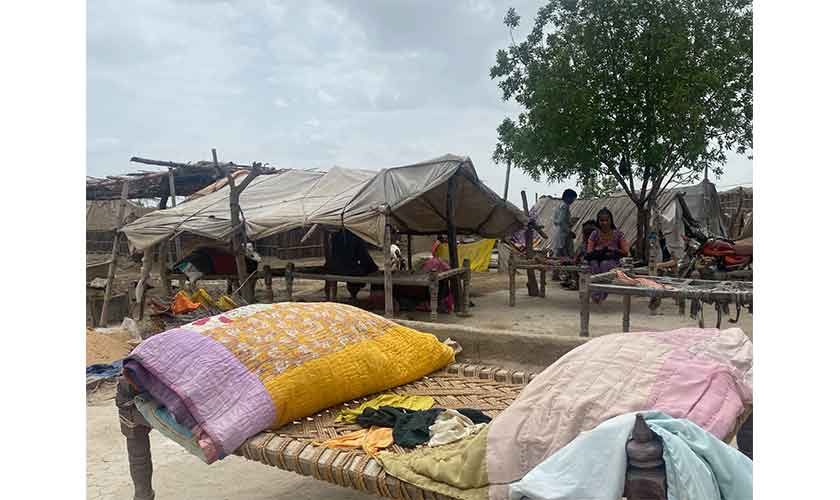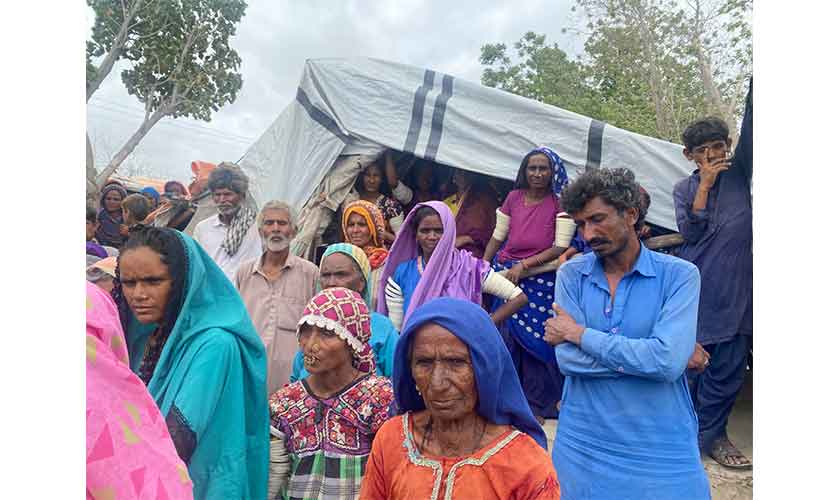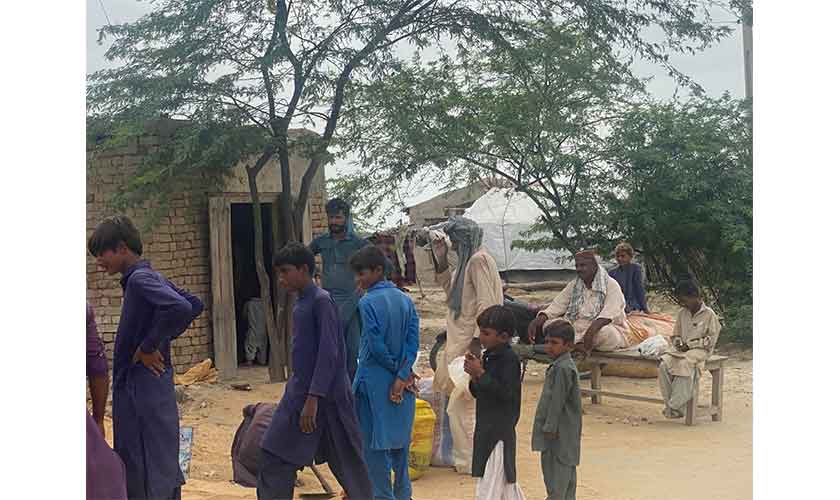akistan faced a huge disaster in 2022 as heavy rains triggered terrible floods. Sindh and Balochistan were hit particularly hard. After the floods, people discussed whether climate change alone had caused the crisis. Some said that the massive rainfall was the main reason for the damage; others believed that poor drainage systems had aggravated the impact of the calamity.
Poor drainage remains a problem for the coastal communities in Badin. Jarar Bhel village, situated 85 kilometres from Badin, was hit hard by the 2022 floods. People in the village say that the deliberate breach of the Left Bank Outfall Drain was meant to protect farmlands owned by influential families at the cost of marginalised communities.
“I’ve been witness to three deliberate breaches of the LBOD, causing the drowning of our village. Our houses and everything in those were washed away. We’re struggling to make a living among these ruins,” says Jammo, a resident of Jarar Bhel.
A few villagers mentioned that the LBOD breach is worse for them than the floods themselves. Officials say the LBOD cut in 2022 was made to protect the more populated Pangrio town.
The drain
The Left Bank Outfall Drain project was started in 1984. It was meant mainly to deal with waterlogging and salinity in the region. Their plan was to create a connected drainage system that would reach the sea through a spinal drain and a tidal link.
Covering 1.27 million acres of farmland on the left flank of Indus River, the project consists of four main parts. These are the Spinal Drain, the Kadhan Pateji Outfall Drain (KPOD), the Dhoro Puran Outfall Drain (DPOD) and the Tidal Link.
After reservations were raised about the environmental impact of the Tidal Link, it was decided to raise the northern wall as a precaution and to build the Cholri weir. Even so, there were problems during operation, including erosion and scouring. A part of the Cholri weir collapsed in 1999 when a terrible cyclone hit it and broke the Tidal Link wall. This turned the LBOD into a “new river” and affected the coast.
The impact of 2022 flood
A report by the Badin district commissioner says that until October 2022, about 50,000 families remained homeless due to the floods. The Left Bank Outfall Drain, designed to handle 4,600 cubic feet per second (cusecs) of water, was carrying an unexpected surge of 12,000 cusecs during the flood.
A conference on the LBOD, organised by a group of volunteers, was held in February 2023 to discuss the issues and try to find some solutions. It was attended by lawmakers, educationists, experts and victims of the devastating floods. A statement issued at the end of the conference asked the government that original waterways be fixed, enchrochments eliminated and that the LBOD be redesigned to reduce the destruction caused by floods.
Narain Kohli, a Badin-based activist, one of the organisers of the conference, told TNS that Badin did not have enough water. “In the ’80s and ’90s, there used to be about 300 lakes in Badin. Only two or three are left now. Those, too, are drying up. The polluted water in the LBOD is also a big problem for the people and the farmland.”
Fear of drowning
The people living along the river bank in Badin, are always worried about unexpected rains and the possibility of a drain breach
“Last year, they made a cut in the LBOD’s Malkani bridge near our village. It caused terrible flooding. The government claimed that this was done to protect the people and farmlands in the Pangrio area,“ Jaan Bhel tells TNS.
Some of the floodwater is still standing in Badin. Millions of people are still in need of assistance.
“We had few belongings. Even those got washed away by the floods. I’m a heart patient. I used to receive treatment at a local government hospital. After spending three to four months in relief camps, we returned to our village where conditions have worsened, making it impossible for me to continue my treatment,“ says Aminah, aged 18, a resident of Jarar Bhel.
The Indus Consortium for Humanitarian, Environment and Development Initiatives is a not-for-profit organisation that works to highlight the environmental, disaster risk, and development issues of coastal communities living along the River Indus and its tributaries.
The Consortium has implemented more than 25 multi-partner, multi-district, livelihoods, irrigation, water governance, climate change and humanitarian projects. The humanitarian programme is currently the core activity of the Indus Consortium.
“There are 150 to 200 families, including pregnant women and children, in Jarar Bhel. The consortium, partnering with Oxfam Pakistan and a local organisation, Laar, is currently working in Jarar Bhel and adjoining villages to provide basic health and other facilities,” says Qurat-ul-Ain Rizwan, the project manager.
The World Bank assessment shows that Sindh needs $7.9 billion for recovery and reconstruction after the floods.
Around two million people, about half of them women, will gain from fixing and making critical infrastructure stronger. About 100,000 households will get help for their livelihoods through programmes like cash-for-work and restoring livestock.
The way forward
Khalid Memon, a former secretary of Irrigation Department says that the rainwater drainage system should be separated from the LBOD.
He says constructing a proper drainage system is highly important to remove saline water from farmland as it could harm crops and the soil. Drainage systems have been built on both sides of the Indus Delta for this purpose. The LBOD was built to remove water from the fields and drain it into the sea. However, the LBOD hasn’t been very successful.
The writer is a journalist based in Karachi
https://www.thenews.com.pk/tns/detail/1103963-draining-floodwater



